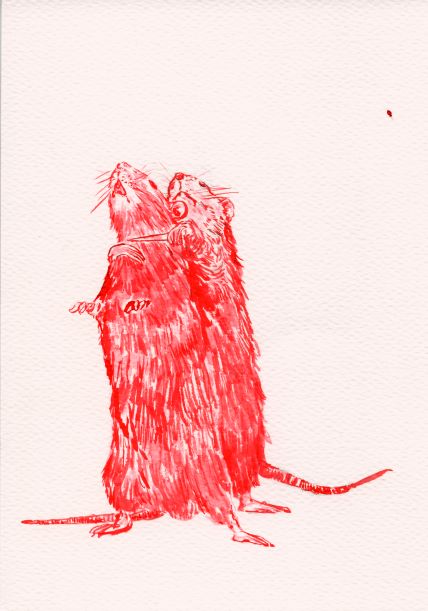
03.02.2023
Through this section, monthly, we invite agents of the artistic system to share a selection of images related to their practice or current interests. Images are published daily in the header of our website and shared through our Instagram profile. At the end of the month, the complete selection of images is published together with a text that contextualizes them. Here is the selection of January 2023.
Manual Oracle Towards the End of Everything
“Everything suggests the hypothesis that history will pass and, with it, the being to whose detriment it was constructed”
M. Cioran[1]

There are imaginary worlds so decadent that it’s easy for them to escape logic and avoid being carried on our backs. Such is the case of the universe of atavistic filth posed by Gustavo Abascal in his series of rodents—sometimes despicable, others more adorable and suggestive. However, like any fictitious world incapable of sustaining itself, it is better to direct it towards the absurd, the ominous and, if possible, towards its end. The danger of this cosmogony is, if anything, that it may turn out to be too real.
Gustavo Abascal’s rats arise from the impossibility of accepting what they symbolize: the disturbance of a system, of an order. It could be because they reflect a tireless misfortune of self-complacency, of flattery, where pests and human beings seem interchangeable. They are a kind of elucidated “I” in the contemporary vertigo, or perhaps a defense mechanism to cope with the anxieties of the world and, simultaneously, to be carried away by them.
But, after the deception of representation, comes weariness. The fundamental problem of these rodents lies in the fact that they have devoured the world that should have welcomed them. Faced with this enormous loss, they can only rely on delusions that flee to reason: God, freedom, genitals, art, capital, Milton and Bataille. Pathology illuminates the norm and the result is consequent: social unrest and unbearable ideologies with which our idolatry must grapple with. How may we endure much longer?
Victims of a double atrocity, Abascal’s rodents congregate in burrows, prowl, copulate and kill, confirming their usual behavior; on top of that, they also become gods, monarchs or hierarchs, thus plaguing the inhospitable terrain they take over for the proliferation of their species. Something that is disgustingly familiar to us, since it is only possible to recognize such a kingdom when one lives in it.
As if following an oracle between resignation and hope, for better days, the time of the end,[2] the question is inevitable: could it be different? Meanwhile, we find ourselves on the threshold of a grotesque reality where not only desolate imagination is needed to approach these rats, but of a particular skill一either the power of transfiguration or, perhaps, a more sophisticated sensibility to forget our species and, paradoxically, get closer to it.
Perhaps Abascal’s anthropomorphic exercise is a sort of poetic culmination to inhabit a dystopia where repugnance is, at the same time, an emblem of devotion. Thus, the alternation between the sublime and the abject characterizes what is as heartbreaking as it is luminous in any species: its very existence.
Cioran, E. M. Drawn and Quartered. USA: Arcade Publishing, 2012, p. 53.
Ibid
Comments
There are no coments available.